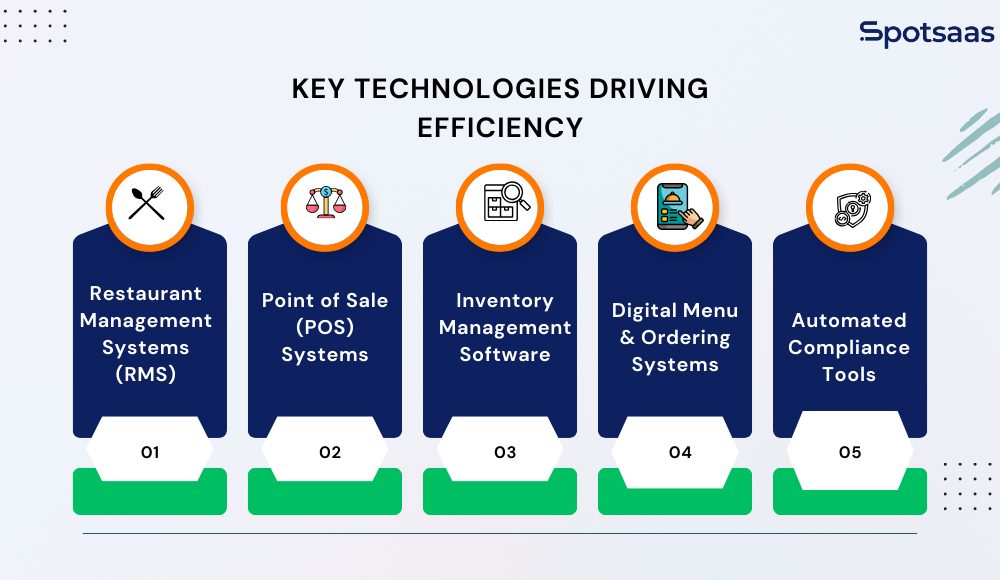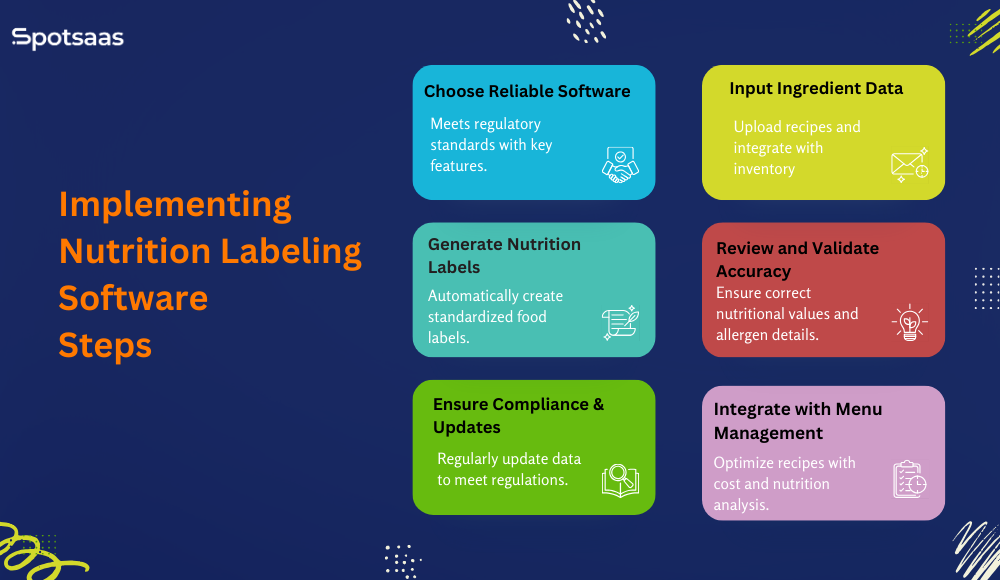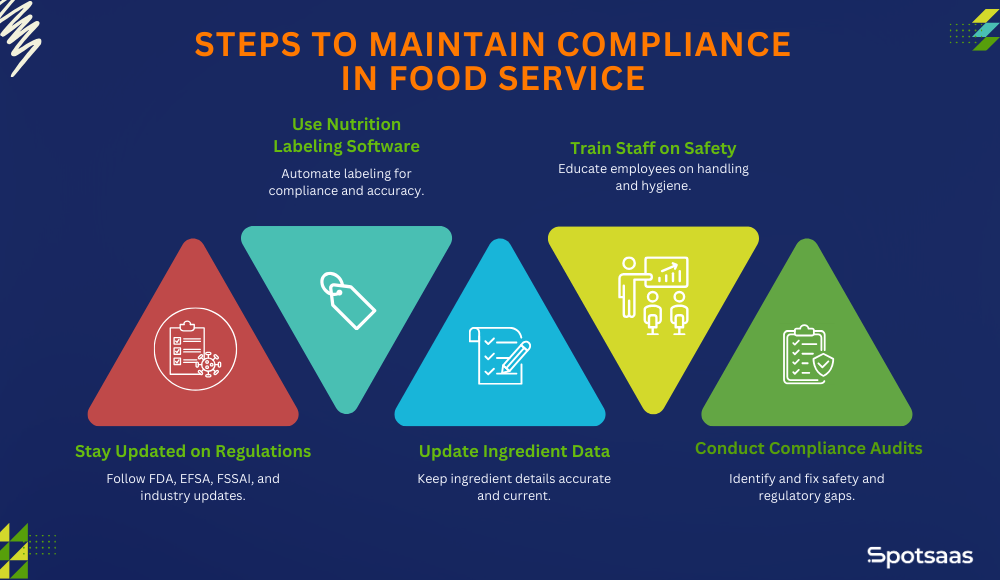Food service management is more competitive than ever, requiring businesses to maximize efficiency and organization in their daily operations. Companies must embrace technology to streamline workflows, enhance customer experiences, and maintain profitability to stay ahead.
The right tools, from restaurant management systems to advanced inventory controls and nutrition labeling software, can revolutionize food service operations.
This article explores key technologies that drive efficiency and order in food service management, their impact on business performance, and the benefits of integrating them into daily operations.
Essential Tools and Technologies in Food Service
The food service industry uses technology-driven tools to ensure smooth and efficient operations. These innovations help businesses save time, reduce costs, and enhance customer experience.
By integrating these tools into daily operations, restaurants and food establishments can streamline workflows, improve decision-making, and stay competitive in a fast-evolving market.
Key Technologies Driving Efficiency

Restaurant Management Systems (RMS)
A restaurant management system (RMS) is the backbone of modern food service operations. These centralized platforms provide an all-in-one solution for monitoring various business aspects, including sales, inventory, employee performance, and customer interactions.
By integrating multiple processes into one system, RMS reduces manual workload and improves accuracy.
Point of Sale (POS) Systems
Modern POS systems go beyond processing transactions; they are essential for managing customer data, inventory levels, and business analytics.
Integrated with digital payment solutions, cloud-based POS systems allow restaurants to track sales in real-time, streamline order processing, and even implement loyalty programs.
Inventory Management Software
Inventory management software is crucial for reducing food waste and controlling costs. This technology automates stock tracking, ensuring businesses have the right ingredients at the right time without over-purchasing.
The software can forecast demand based on sales trends, helping restaurants optimize their supply chain and avoid stock shortages.
Digital Menu and Ordering Systems
Digital menus and online ordering systems have revolutionized how customers interact with food service businesses. By providing an easy-to-navigate digital menu, customers can browse food options, customize their meals, and place orders conveniently from their mobile devices.
They also enhance efficiency by reducing wait times, minimizing order errors, and enabling seamless integration with delivery and payment platforms.
Automated Compliance Tools
Compliance with evolving food safety regulations is crucial in food service management. Automated compliance tools help businesses stay updated, track expiration dates, monitor food handling, and generate reports to ensure regulatory adherence.
By automating these tasks, businesses minimize legal risks, maintain high food safety standards, and focus on quality service.
Comprehensive Restaurant Management Systems
A Restaurant Management System (RMS) integrates key functions into a centralized platform, streamlining operations and enhancing efficiency. It automates tasks, reduces errors, and provides real-time analytics for better decision-making.
An RMS improves customer service, minimizes wait times, and ensures accurate orders by optimizing order processing, inventory tracking, and staff performance. It seamlessly integrates with POS, inventory, and CRM tools and is the backbone of modern restaurant operations.
Benefits of Implementing an RMS
By integrating an RMS, food service businesses can operate more efficiently, improve profitability, and enhance the overall dining experience for their customers.
| Benefit | Impact on Business |
|---|---|
| Real-Time Data Tracking | Provides insights on sales, inventory, and staff performance for better decision-making. |
| Centralized Order Management | Reduces delays and errors by streamlining dine-in, takeout, and delivery orders. |
| Automated Inventory Updates | Prevents shortages and overstocking, reducing food waste and costs. |
| Enhanced Customer Experience | Improves service speed and accuracy, leading to higher customer satisfaction. |
| Employee Performance Monitoring | Tracks staff productivity, helping to optimize labor costs and training needs. |
| Integrated Payment Solutions | Supports multiple payment methods, enhancing convenience for customers. |
| Comprehensive Reporting and Analytics | Helps identify trends, forecast demand, and make data-driven business improvements. |
Inventory Management and Cost Control
Effective inventory management is crucial for maintaining profitability in the food service industry. Advanced inventory management software enables restaurants to track stock levels, predict demand, and minimize waste through automation, ultimately improving cost efficiency and streamlining operations.
Advantages of Automated Inventory Management:
Real-Time Stock Updates
Automated systems provide real-time visibility into inventory levels, tracking ingredient usage down to the unit. This prevents unexpected shortages and ensures restaurants can meet customer demands without disruptions.
Waste Reduction
Over-purchasing and spoilage are major cost factors in the food industry. Inventory management software helps set reorder thresholds and expiration alerts to prevent excess stock from going to waste.
Restaurants can monitor ingredient shelf life, rotate stock effectively, and make data-driven purchasing decisions to minimize food waste.
Demand Forecasting
The system predicts future inventory needs by analyzing historical sales data, seasonality trends, and customer preferences. This helps restaurants align stock levels with anticipated demand, ensuring they have the right ingredients.
Supplier Integration
Automated inventory systems streamline procurement by integrating with supplier networks. This allows for automatic order placements when stock reaches a predefined threshold, reducing the risk of stockouts and delays.
Optimizing Recipe and Menu Management in Restaurants
Consistency in recipe and menu management is key to ensuring high-quality dishes, maintaining brand reputation, and enhancing customer satisfaction.
By leveraging nutrition labeling software, restaurants can streamline their menu management process, provide accurate nutritional information, and comply with food labeling regulations.
Steps to Implement Nutrition Labeling Software

Step 1: Select a Reliable Software Solution
Choose software that meets local and international food regulatory standards, such as the FDA (U.S.), EFSA (Europe), or FSSAI (India). To ensure accuracy and compliance, look for features like allergen tracking, cost analysis, and real-time updates.
Step 2: Input Ingredient Data
Upload recipes, ingredient details, and supplier information into the system. Verify ingredient sources and portion sizes to ensure accuracy. Many software solutions integrate with inventory management systems, allowing seamless updates and reducing manual data entry.
Step 3: Generate Nutrition Labels
Once ingredient data is entered, the system automatically calculates and generates standardized nutrition labels for menu items. This process helps maintain consistency across multiple restaurant locations and provides customers with accurate nutritional information.
Step 4: Ensure Compliance and Regular Updates
Regulatory requirements for food labeling frequently change. Regularly updating ingredient information, nutritional values, and allergen details ensures continued compliance with food safety laws and enhances customer safety. Keeping up with these updates also helps prevent potential legal issues or fines.
Step 5: Integrate with Menu Management for Optimization
Nutrition labeling software can help refine recipes based on cost analysis and customer preferences.
Businesses can adjust portion sizes, swap ingredients for cost-effective alternatives, and design healthier menu options without compromising taste. This integration ensures better menu planning, cost control, and customer satisfaction.
Enhancing Customer Experience with Technology
Technology transforms customer engagement and satisfaction by making dining experiences more convenient, personalized, and efficient.
With digital menus, online ordering systems, and AI-driven marketing, restaurants can cater to modern consumers who prioritize speed, convenience, and transparency in their dining choices.
How Technology Enhances Customer Experience
Personalized Recommendations
AI-powered systems analyze customer preferences, previous orders, and browsing habits to offer personalized food suggestions. This enhances the dining experience by tailoring recommendations to individual tastes, leading to higher customer satisfaction and increased sales.
Loyalty programs integrated with AI can reward frequent customers with custom discounts and exclusive deals.
Mobile-Friendly Menus and Online Ordering
Digital menus and mobile ordering platforms allow customers to browse menus, customize orders, and place requests seamlessly from their smartphones.
These menus often include nutrition details, allergen information, and dietary filters, helping health-conscious consumers make informed choices. Mobile ordering systems also reduce wait times, ensuring smoother and faster service.
Faster and More Efficient Service
Real-time order tracking and optimized workflows enable restaurants to handle orders more efficiently. With technology-integrated kitchen display systems (KDS), orders are instantly relayed to the kitchen, minimizing errors and ensuring quicker preparation.
Automated processes like digital check-ins and self-service kiosks reduce wait times and enhance overall service speed.
Enhanced Customer Engagement Through Marketing
AI-driven marketing and customer data analytics allow restaurants to send customers targeted promotions, exclusive deals, and personalized messages.
Businesses can use push notifications, email campaigns, and loyalty rewards programs to increase repeat visits and build long-term customer relationships.
Seamless Payment and Contactless Transactions
Digital wallets, QR code payments, and contactless transactions have simplified the checkout process, making it faster and more secure. Mobile payment options reduce the need for physical cash or credit cards, ensuring a frictionless dining experience.
By integrating these technologies, restaurants can enhance convenience, improve efficiency, and create a more personalized dining journey, leading to higher customer satisfaction and long-term loyalty.
Ensuring Compliance and Safety
Regulatory compliance is essential in food service, ensuring safety, transparency, and legal adherence. Various global bodies, like the FDA (U.S.), EFSA (Europe), and FSSAI (India), enforce food safety and labeling laws, with non-compliance leading to penalties and reputational risks.
Nutrition labeling software aids compliance by generating accurate data, adapting to evolving regulations, and minimizing legal risks. Integrating compliance management tools streamlines regulatory processes and keeps businesses updated with industry standards.
Steps to Maintain Compliance in Food Service
Ensuring compliance in food service requires continuous monitoring of regulations, accurate labeling, and proper staff training.

Stay Informed About Regulations
Keeping up with food safety regulations is essential for ensuring compliance and avoiding penalties. Regulatory bodies like the FDA (U.S.), EFSA (Europe), and FSSAI (India) frequently update food safety laws, labeling requirements, and hygiene standards.
Businesses should regularly check official sources, attend industry seminars, and subscribe to updates from regulatory agencies to stay informed and implement changes as required.
How to Stay Updated:
- Follow regulatory websites and food safety organizations for real-time updates.
- Subscribe to newsletters and industry publications.
- Participate in training programs and compliance workshops.
- Consult legal or compliance experts to ensure adherence to the latest regulations.
Implement Nutrition Labeling Software
Accurate food labeling is crucial for both compliance and customer transparency. Nutrition labeling software automates calculating calories, allergens, and macronutrient content, ensuring food labels meet the latest regulatory standards.
This technology minimizes human errors, simplifies compliance, and allows businesses to provide customers with clear, standardized nutritional information.
Benefits of Using Nutrition Labeling Software:
- Ensures compliance with regional and international food labeling laws.
- Automates calculations for calories, allergens, and nutritional values.
- Reduces human errors in food labeling and ingredient tracking.
- Enhances customer trust by providing accurate dietary information.
- Integrates with menu management for real-time updates and modifications.
Regularly Update Ingredient Data
Ingredient formulations change over time due to supplier variations, reformulations, or regulatory adjustments. Businesses must regularly update their ingredient database to maintain accuracy in nutritional values, allergens, and ingredient lists.
This practice ensures compliance with food safety laws and provides consumers with the correct dietary information, reducing the risk of allergic reactions or misinformation.
Best Practices for Ingredient Data Management:
- Review ingredient specifications and supplier information regularly.
- Update ingredient databases whenever recipes or formulations change.
- Use digital inventory management systems to automate ingredient tracking.
- Verify nutritional and allergen content after switching suppliers or brands.
Train Staff on Food Safety Regulations
Proper food handling, storage, and hygiene are critical in preventing contamination and ensuring food safety. Businesses should conduct regular training sessions to educate employees on regulatory standards, allergen management, and safe food preparation.
Well-trained staff can help maintain compliance, improve workplace safety, and reduce the risk of foodborne illnesses, protecting customers and the business reputation.
Key Areas of Food Safety Training:
- Personal hygiene and proper handwashing techniques.
- Safe food handling, preparation, and storage procedures.
- Cross-contamination prevention and allergen management.
- Understanding and implementing food safety regulations.
Conduct Routine Compliance Audits
Regular internal audits and third-party inspections help identify gaps in food safety practices and ensure ongoing regulatory compliance. These audits evaluate food handling, sanitation procedures, labeling accuracy, and employee adherence to safety protocols.
Addressing potential risks early prevents violations, legal consequences, and operational disruptions, ensuring a well-managed and compliant food service business.
Steps for Conducting Effective Compliance Audits:
- Perform internal inspections at scheduled intervals.
- Document findings and implement corrective actions promptly.
- Involve third-party auditors for unbiased compliance evaluations.
- Maintain proper records of safety checks and regulatory adherence.
The table below outlines key steps to maintain food safety and regulatory adherence.
| Step | Description |
|---|---|
| Stay Informed About Regulations | Monitor updates from regulatory agencies and ensure adherence to food safety laws. |
| Implement Nutrition Labeling Software | Use automated software to generate accurate nutritional labels and ensure compliance. |
| Regularly Update Ingredient Data | Keep ingredient and recipe data up to date to reflect accurate nutritional values. |
| Train Staff on Food Safety Regulations | Educate employees on food safety handling, allergen management, and compliance. |
| Conduct Routine Compliance Audits | Perform internal audits and third-party inspections to address compliance risks. |
The Future of Technology in Food Service
The role of technology in the food service industry is rapidly evolving, shaping how restaurants operate and interact with customers. As digital advancements continue, businesses that embrace emerging technologies will experience greater efficiency, improved customer satisfaction, and increased profitability.
These innovations, from AI-driven menu optimization to robotic automation, are revolutionizing food service operations.
Emerging Trends in Food Service Technology
AI and Machine Learning in Menu Planning
Artificial Intelligence (AI) and machine learning are transforming menu planning by analyzing customer preferences, dietary trends, and purchasing behavior. These technologies help restaurants optimize their menu offerings, reduce food waste, and create personalized recommendations based on past orders.
AI-driven pricing strategies can also help maximize profitability by adjusting prices dynamically based on demand and ingredient costs.
Robotic Automation in Kitchens
Introducing robotics in commercial kitchens enhances food preparation efficiency, consistency, and speed. Automated cooking systems, robotic chefs, and self-operating fryers are helping restaurants reduce labor costs, minimize errors, and improve order accuracy.
Some fast-food chains and high-volume kitchens already use robotic arms to flip burgers, assemble pizzas, and plate dishes.
Blockchain for Food Safety
Blockchain technology is improving food traceability and supply chain transparency. Blockchain ensures that food safety standards are met throughout the supply chain by recording ingredient origins, expiration dates, and handling processes on a tamper-proof digital ledger.
This technology helps prevent food fraud, reduce contamination risks, and build consumer trust by providing real-time insights into product sourcing and quality control.
Sustainable Tech Solutions
Sustainability is a growing concern in the food industry, and technology is critical to promoting eco-friendly practices.
Innovations such as waste management systems, energy-efficient kitchen appliances, and AI-driven food inventory tracking help restaurants reduce waste, lower energy consumption, and adopt sustainable sourcing strategies.
Many businesses use biodegradable packaging and carbon footprint tracking tools to meet environmental goals.
By adopting these emerging technologies, food service businesses can stay competitive, enhance operational efficiency, and align with changing consumer expectations. Investing in tech-driven solutions will be essential for long-term success as the industry evolves.
Conclusion
In today’s fast-paced food service industry, maximizing efficiency is essential. Integrated restaurant management systems, advanced inventory control, and nutrition labeling software streamline operations, reduce waste, and enhance profitability.
As customer expectations rise, especially in health-conscious dining, leveraging technology ensures businesses remain competitive and compliant. Food service managers should actively adopt these innovations to improve operations and position their companies for long-term success.
By embracing these advancements, businesses can exceed customer expectations and thrive in an evolving market.
FAQs on Food Service Management
How does a Restaurant Management System (RMS) improve efficiency?
An RMS centralizes order management, inventory tracking, and staff monitoring, reducing errors and automating tasks for better decision-making and customer satisfaction.
Why is inventory management software essential?
It ensures compliance, generates accurate nutritional labels, tracks allergens, and provides transparency for health-conscious consumers.
How do digital menus and online ordering improve customer experience?
They allow easy browsing, customization, and ordering, reducing wait times and order errors while enhancing convenience and satisfaction.
How does nutrition labeling software benefit food businesses?
It ensures compliance, generates accurate nutritional labels, tracks allergens, and provides transparency for health-conscious consumers.
What are key emerging trends in food service technology?
AI-driven menu optimization, robotic automation, blockchain for food safety, and sustainable tech solutions improve efficiency, transparency, and eco-friendliness.



